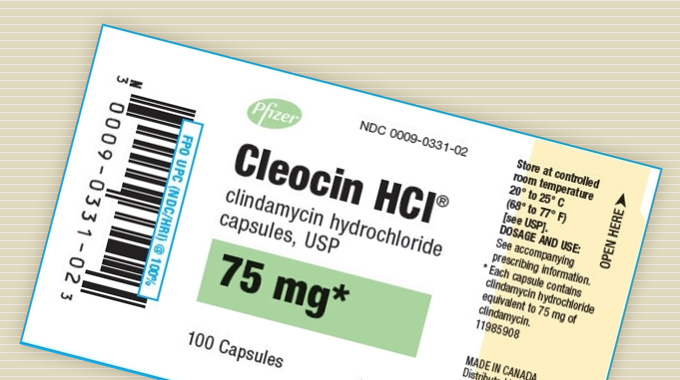Cleocin (clindamycin)
The generic name of this drug is clindamycin. It is an antibiotic drug used for the treatment of some serious infections caused by bacteria. The group this medication belongs to is called lincomycin or lincosamide antibiotics. It helps in preventing the growth of bacteria and stops spreading the infection. Cleocin was approved by the Food and Drug Administration (FDA) in the year 1970.
There are many forms in which this medication is available. Some of them are:
- Capsules
- Gels
- Injection
- Creams
- Solutions

Dosage
The recommended dosage for Cleocin (generic name: clindamycin) can vary depending on the specific infection being treated and the individual's medical condition. It is essential to follow your healthcare provider's instructions or the directions on the prescription label. Generally, the typical adult dosage for Cleocin is as follows:
For most infections:
- Oral Capsules: The usual adult dose ranges from 150 to 450 mg every 6 to 8 hours.
- Intravenous (IV) Injection: The usual adult dose ranges from 600 to 1,200 mg per day divided into 2 to 4 equal doses.
For more severe infections:
- Oral Capsules: The usual adult dose ranges from 300 to 450 mg every 6 hours.
- Intravenous (IV) Injection: The usual adult dose ranges from 1,200 to 2,700 mg per day divided into 2 to 4 equal doses.
Composition
Cleocin is a semisynthetic antibiotic that contains clindamycin hydrochloride in its capsules. The inactive ingredients present in these capsules are:
- FD&C Blue No. 1
- Corn starch
- Gelatin
- FD&C Yellow No. 5
- Lactose
- Talc
- Magnesium stearate
- Titanium dioxide
Uses
They are used for the treatment of a wide variety of infections caused by bacteria. Some of them are:
- Acne
- Vaginal infection resulting from bacteria
- Pelvic inflammatory disease (PID)
- Meningitis
- Bacterial community-acquired pneumonia (CAP)
- Severe middle ear infection
- Severe sinus infection
This antibiotic only works in treating bacterial infections. They are not useful in treating viral infections (like flu and common cold). The misuse and unnecessary usage of this drug may reduce its efficiency.
Side-effects
There are many side-effects associated with the use of cleocin which may require medical attention. Some of these side-effects are:
- Cracks appearing on the skin
- Swollen and red skin
- Scaly skin
- Reduced heat in the body
- Tarry and black stools
- Stomach or abdominal cramps, tenderness, or pain
- Bleeding gums
- Peeling, loosening, or blistering of the skin
- Blood in the stools or the urine
- Bloating
- Blurred vision
- Chills
- Chest pain
- Cloudy urine
- Confusion
- Hoarseness or cough
- Dark urine
- Diarrhoea
- Decreased amount of urine
- Dizziness
- Difficulty in swallowing
- Dry mouth
- Faintness,
- Fast heartbeat
- Fever
- Headache
- Heart stops
- Heartburn
- Increased thirst
- Skin rash,
- Loss of appetite
- Muscle or joint pain
- Vomiting or nausea
- No breathing
- No blood pressure or pulse
- Pain while having sexual intercourse
- Side or lower back pain
- Difficult or painful urination
- Swelling on lips
- Irritated and red eyes
- Skin turning red
- Breathlessness
- Sore throat
- Ulcers,
- Thirst
- Swollen glands

Contraindications
Under the following conditions the patient must be refrained from using this medication:
- Allergic reaction to lincosamides
- Atopic Dermatitis
- Kidney problems
- Liver disease
- Diarrhoea
- Ulcerated Colon
- Crohn’s Disease
- Clostridium Difficile Bacteria Related Colitis
Cleocin and pregnancy
Cleocin is listed by the FDA in the Pregnancy Category B. There has been no evidence of fetal harm during the use of this medicine. Nonetheless, the doctor should be informed if the patient is pregnant or plans on being pregnant.
Some frequently asked questions about Clindamycin
What is clindamycin?
Clindamycin is an antibiotic medication that belongs to the lincosamide class. It is commonly prescribed to treat various bacterial infections.
How does clindamycin work?
Clindamycin works by inhibiting the growth and reproduction of bacteria. It does this by binding to the bacterial ribosomes, which are essential for protein synthesis. By interfering with protein production, clindamycin effectively stops the bacteria from multiplying and helps to eliminate the infection.
What types of infections can clindamycin treat?
Clindamycin is effective against a wide range of bacterial infections, including skin and soft tissue infections, respiratory tract infections, bone and joint infections, pelvic inflammatory disease, intra-abdominal infections, and certain dental infections.
Is clindamycin suitable for everyone?
While clindamycin is generally safe and effective, it may not be suitable for everyone. Individuals with a history of allergies to clindamycin or other antibiotics in the lincosamide class should avoid its use. It is crucial to inform your healthcare provider about any existing medical conditions or medications you are taking before starting clindamycin.
What are the common side effects of clindamycin?
Common side effects of clindamycin may include nausea, vomiting, diarrhea, abdominal pain, rash, itching, and yeast infections. If you experience severe or persistent side effects, it is important to contact your healthcare provider.
Can clindamycin interact with other medications?
Yes, clindamycin can interact with certain medications, including erythromycin, other antibiotics, and medications that affect liver enzymes. It is essential to inform your healthcare provider about all the medications, supplements, or herbal products you are taking to avoid any potential interactions.
How should clindamycin be taken?
Clindamycin is available in various forms, including capsules, tablets, creams, gels, and injections. The specific instructions for taking clindamycin will depend on the formulation and the condition being treated. Always follow your healthcare provider's instructions or the directions on the prescription label.
Can clindamycin be used during pregnancy or while breastfeeding?
Clindamycin is generally considered safe to use during pregnancy and while breastfeeding. However, it is important to consult with your healthcare provider before using any medication to assess the potential risks and benefits in your specific situation.
What should I do if I miss a dose of clindamycin?
If you miss a dose of clindamycin, take it as soon as you remember. However, if it is close to the time for your next scheduled dose, skip the missed dose and continue with your regular dosing schedule. Do not double the dose to make up for the missed one.
How long should I take clindamycin?
The duration of clindamycin treatment can vary depending on the type and severity of the infection. It is crucial to complete the full course of medication as prescribed by your healthcare provider, even if you start feeling better before the treatment period ends. Stopping the medication prematurely may allow the bacteria to return or develop resistance to the antibiotic.
- Download in PDF » Cleocin: Product Information


